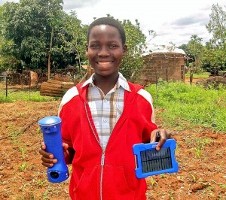
The solar-powered Lifelight by Lifeline Energy is one of the technologies on the Energy Map (Lifeline Energy)
Santa Clara University in California and social-enterprise information company Ayllu have created the Energy Map Web site that offers graphs and analyses of 40 social enterprises in 16 countries that bring electricity or alternative fuel to communities of 500 to 500,000 people each. All 40 of the sites involve energy produced or consumed outside of established power distribution networks.
Visitors to the Energy Map can get an overview of the types of distribution systems, business models, technologies, and product designs being employed. The map also provides detailed financial and business model profiles of the companies bringing electricity and clean fuel to these communities around the world.
Santa Clara’s Center for Science, Technology, and Society (CSTS) estimates that 1.4 billion people live in areas of the world so remote that no major electricity grid projects are expected to come their way for years. And some three billion people must cook with polluting, unhealthy stoves or over open fires.
The 40 enterprises on the map serve several million customers. They include a company in India turning discarded rice husks into affordable electricity for villagers, as well as a Nicaraguan company that trains workers to build and maintain hybrid energy plants. Also among the sites is a Nigerian company that turns cow slaughterhouse waste into electricity. Each of the companies on the Energy Map has either won a Tech Award from the Silicon Valley-based Tech Museum or has gone through Santa Clara’s Global Social Benefit Incubator, an eight-month capacity- and skill-building program offered by CSTS.
The university says the Energy Map offers NGOs, funders, and investors a snapshot of promising off-grid energy solutions serving remote and rural regions. The map can also offer ideas to other social entrepreneurs crafting solutions in their communities.
* * *

 RSS - Posts
RSS - Posts
You must be logged in to post a comment.